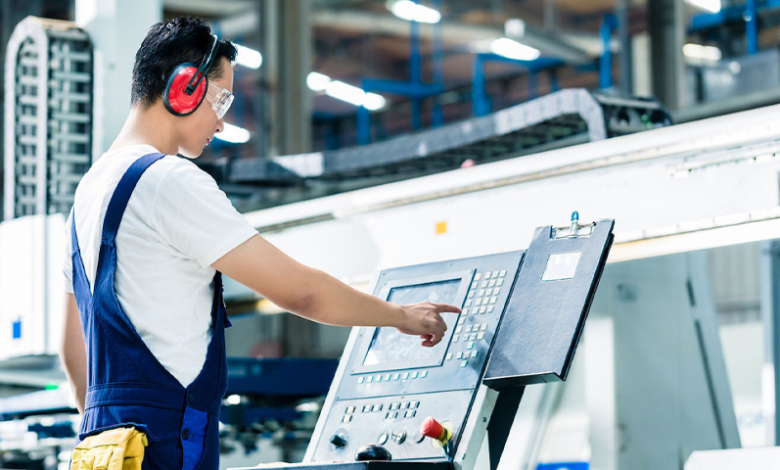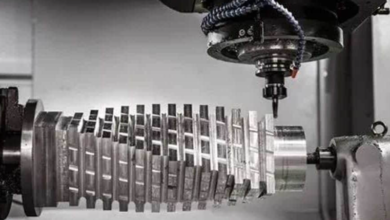CNC Machining: Principles and Applications Explained

CNC machining is an automated manufacturing process that uses pre-programmed software to control machine tools, enabling the production of precise and complex parts with high accuracy. Widely used across industries like automotive and medical, it streamlines the creation of intricate geometries that would be difficult to achieve manually. This guide covers how CNC machining works, its components, operations, and applications in modern manufacturing.
Basic Principles of CNC Technology: How it Works
CNC machining operates on a straightforward principle: computer-controlled automation replaces manual machine operation. The process begins with a digital design file, typically created using Computer-Aided Design (CAD) software. This design is then converted into a set of numerical instructions using Computer-Aided Manufacturing (CAM) software.
These instructions, known as G-code, tell the machine exactly where to move, how fast to operate, and which tools to use. The CNC machine reads this code and executes the programmed movements with exceptional precision, often within tolerances of a few thousandths of an inch.
The automated nature of CNC machining eliminates human error during production while enabling 24/7 operation. Once programmed, machines can run continuously with minimal supervision, dramatically increasing productivity compared to manual machining methods.
Key Components of a CNC Machine
Understanding the essential components of CNC machines helps explain how they achieve such remarkable precision and versatility.
Control Unit
The control unit serves as the brain of the CNC machine. It interprets the G-code instructions and coordinates all machine movements. Modern control units feature user-friendly interfaces that allow operators to load programs, monitor operations, and make adjustments as needed.
Drive System
The drive system converts electrical signals from the control unit into precise mechanical movements. Most CNC machines use servo motors or stepper motors, which provide the accuracy and repeatability essential for quality manufacturing.
Machine Structure
The machine structure provides the rigid framework necessary for precise operations. This includes the machine bed, columns, and ways that guide tool movement. High-quality CNC machines feature heavy-duty construction to minimize vibration and maintain accuracy during operation.
Spindle and Tool System
The spindle holds and rotates cutting tools at various speeds. Advanced CNC machines often include automatic tool changers, allowing them to switch between different tools during a single operation without manual intervention.
See also: AI in Education: How Technology Is Shaping Future Classrooms
Common CNC Machining Operations
CNC technology supports numerous machining operations, each suited to specific manufacturing requirements.
Milling
CNC milling uses rotating cutting tools to remove material from a workpiece. The workpiece typically remains stationary while the cutting tool moves along multiple axes. This operation excels at creating complex shapes, slots, holes, and surface features with exceptional accuracy.
Turning
CNC turning involves rotating the workpiece while a cutting tool moves along its surface. This operation is ideal for creating cylindrical parts such as shafts, bushings, and threaded components. CNC lathes can perform multiple turning operations in a single setup, improving efficiency and accuracy.
Drilling
CNC drilling creates precise holes in workpieces using specialized drill bits. Modern CNC machines can drill multiple holes with consistent depth, diameter, and spacing, making them invaluable for parts requiring numerous fastener holes or cooling channels.
Materials Used in CNC Machining
CNC machines can work with an extensive range of materials, each requiring specific cutting parameters and tool selections.
Metals
Aluminum remains one of the most popular CNC machining materials due to its excellent machinability, light weight, and corrosion resistance. Steel, including both carbon and stainless varieties, offers superior strength for demanding applications. Titanium, while more challenging to machine, provides exceptional strength-to-weight ratios for aerospace and medical applications.
Plastics and Polymers
Engineering plastics like ABS, nylon, and polycarbonate machine well and offer excellent properties for various applications. Advanced polymers such as PEEK provide chemical resistance and high-temperature performance for specialized uses.
Composites and Exotic Materials
CNC machines can also process composite materials, ceramics, and other specialized materials, though these often require specific tooling and cutting strategies to achieve optimal results.
Applications of CNC Machining Across Industries
The versatility of CNC machining makes it indispensable across numerous industries.
Aerospace Industry
Aerospace manufacturers rely on CNC machining for critical components that demand exceptional precision and reliability. Engine components, structural parts, and landing gear assemblies all benefit from the accuracy and repeatability that CNC machines provide. The ability to work with exotic materials like titanium and Inconel makes CNC machining particularly valuable for aerospace applications.
Automotive Sector
The automotive industry uses CNC machining for engine blocks, transmission components, suspension parts, and countless other components. The technology enables mass production of complex geometries while maintaining the tight tolerances required for modern vehicle performance and efficiency.
Medical Device Manufacturing
Medical devices often require intricate geometries and biocompatible materials. CNC machining enables the production of surgical instruments, implants, and diagnostic equipment with the precision necessary for patient safety and device effectiveness. Rapid prototyping capabilities also accelerate medical device development cycles.
Electronics Industry
Electronics manufacturers use CNC machining to create housings, heat sinks, and precision components for various devices. The ability to machine complex cooling channels and precise mounting features makes CNC technology essential for modern electronics manufacturing.
Advantages and Disadvantages of CNC Machining
Advantages
CNC machining offers numerous benefits that make it attractive for modern manufacturing. Superior precision and repeatability ensure consistent part quality across large production runs. The automation reduces labor costs and eliminates human error, while the ability to operate continuously maximizes productivity.
The technology’s versatility allows manufacturers to produce complex geometries that would be impossible with manual methods. Additionally, CNC machines can quickly switch between different parts by simply loading new programs, providing exceptional flexibility for varied production requirements.
Disadvantages
Despite its many advantages, CNC machining does have limitations. High initial equipment costs can be prohibitive for small manufacturers. Complex parts may require expensive tooling and lengthy setup times, making short production runs less economical.
The technology also generates significant waste material, as it’s a subtractive manufacturing process. For some applications, additive manufacturing or other production methods may be more material-efficient.
Future Trends in CNC Machining
CNC machining continues to evolve with advancing technology. Artificial intelligence and machine learning are beginning to optimize cutting parameters and predict maintenance needs, improving efficiency and reducing downtime.
Multi-axis machines are becoming more sophisticated, enabling the production of increasingly complex parts in single setups. Hybrid manufacturing systems that combine CNC machining with additive manufacturing offer new possibilities for part design and production strategies.
Improved sensors and monitoring systems provide real-time feedback on tool wear, part quality, and machine performance, enabling more proactive maintenance and quality control.
Conclusion
CNC machining has revolutionized manufacturing with its precision, efficiency, and versatility, playing a vital role in everything from medical devices to vehicles. As technology evolves, CNC machining will become even more advanced, offering manufacturers a competitive edge with reliable and precise solutions for modern production needs.



